中考英语复习:常见易错题分类解析
- 格式:doc
- 大小:371.50 KB
- 文档页数:69
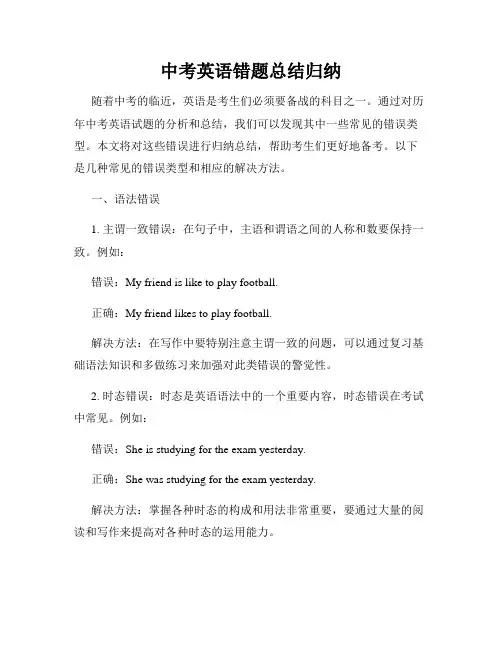
中考英语错题总结归纳随着中考的临近,英语是考生们必须要备战的科目之一。
通过对历年中考英语试题的分析和总结,我们可以发现其中一些常见的错误类型。
本文将对这些错误进行归纳总结,帮助考生们更好地备考。
以下是几种常见的错误类型和相应的解决方法。
一、语法错误1. 主谓一致错误:在句子中,主语和谓语之间的人称和数要保持一致。
例如:错误:My friend is like to play football.正确:My friend likes to play football.解决方法:在写作中要特别注意主谓一致的问题,可以通过复习基础语法知识和多做练习来加强对此类错误的警觉性。
2. 时态错误:时态是英语语法中的一个重要内容,时态错误在考试中常见。
例如:错误:She is studying for the exam yesterday.正确:She was studying for the exam yesterday.解决方法:掌握各种时态的构成和用法非常重要,要通过大量的阅读和写作来提高对各种时态的运用能力。
3. 冠词错误:英语中的冠词使用较为灵活,但在使用过程中容易出错。
例如:错误:I want go to a university in the future.正确:I want to go to a university in the future.解决方法:对于冠词的使用要细心,尤其是在读题和写作时要特别留意。
可以通过积累一些常用搭配和短语来提高冠词的正确使用率。
二、词汇错误1. 词义错误:词义错误指的是在句子中使用了错误的词或者将词语的词义理解错误。
例如:错误:I saw a big house and a small tree.正确:I saw a big house and a small cat.解决方法:在平时的学习中要注重词汇的积累,多读多写可以提高对词义的理解和运用能力。
2. 拼写错误:拼写错误是中考英语中常见的错误类型。
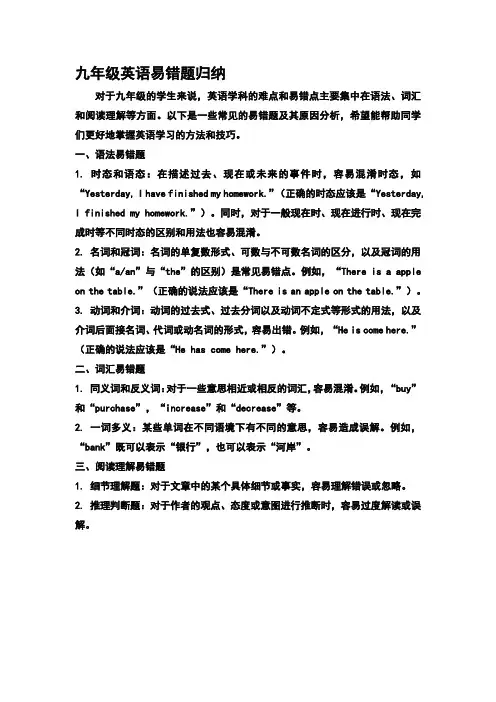
九年级英语易错题归纳对于九年级的学生来说,英语学科的难点和易错点主要集中在语法、词汇和阅读理解等方面。
以下是一些常见的易错题及其原因分析,希望能帮助同学们更好地掌握英语学习的方法和技巧。
一、语法易错题1. 时态和语态:在描述过去、现在或未来的事件时,容易混淆时态,如“Yesterday, I have finished my homework.”(正确的时态应该是“Yesterday, I finished my homework.”)。
同时,对于一般现在时、现在进行时、现在完成时等不同时态的区别和用法也容易混淆。
2. 名词和冠词:名词的单复数形式、可数与不可数名词的区分,以及冠词的用法(如“a/an”与“the”的区别)是常见易错点。
例如,“There is a apple on the table.”(正确的说法应该是“There is an apple on the table.”)。
3. 动词和介词:动词的过去式、过去分词以及动词不定式等形式的用法,以及介词后面接名词、代词或动名词的形式,容易出错。
例如,“He is come here.”(正确的说法应该是“He has come here.”)。
二、词汇易错题1. 同义词和反义词:对于一些意思相近或相反的词汇,容易混淆。
例如,“buy”和“purchase”,“increase”和“decrease”等。
2. 一词多义:某些单词在不同语境下有不同的意思,容易造成误解。
例如,“bank”既可以表示“银行”,也可以表示“河岸”。
三、阅读理解易错题1. 细节理解题:对于文章中的某个具体细节或事实,容易理解错误或忽略。
2. 推理判断题:对于作者的观点、态度或意图进行推断时,容易过度解读或误解。
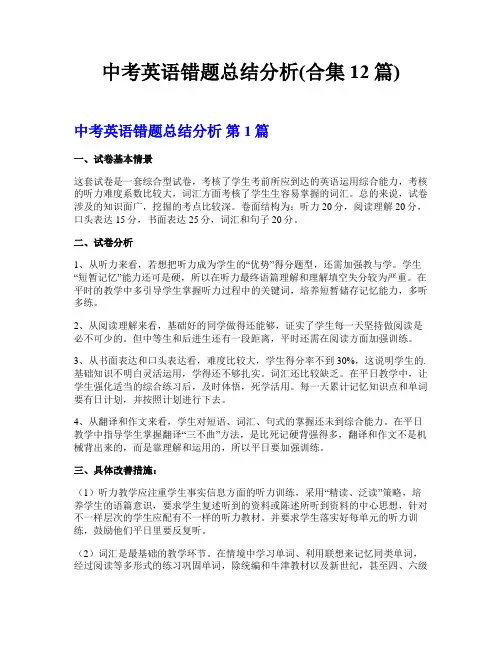
中考英语错题总结分析(合集12篇)中考英语错题总结分析第1篇一、试卷基本情景这套试卷是一套综合型试卷,考核了学生考前所应到达的英语运用综合能力,考核的听力难度系数比较大,词汇方面考核了学生生容易掌握的词汇。
总的来说,试卷涉及的知识面广,挖掘的考点比较深。
卷面结构为:听力20分,阅读理解20分,口头表达15分,书面表达25分,词汇和句子20分。
二、试卷分析1、从听力来看,若想把听力成为学生的“优势”得分题型,还需加强教与学。
学生“短暂记忆”能力还可是硬,所以在听力最终语篇理解和理解填空失分较为严重。
在平时的教学中多引导学生掌握听力过程中的关键词,培养短暂储存记忆能力,多听多练。
2、从阅读理解来看,基础好的同学做得还能够,证实了学生每一天坚持做阅读是必不可少的。
但中等生和后进生还有一段距离,平时还需在阅读方面加强训练。
3、从书面表达和口头表达看,难度比较大,学生得分率不到30%,这说明学生的.基础知识不明白灵活运用,学得还不够扎实。
词汇还比较缺乏。
在平日教学中,让学生强化适当的综合练习后,及时体悟,死学活用。
每一天累计记忆知识点和单词要有日计划,并按照计划进行下去。
4、从翻译和作文来看,学生对短语、词汇、句式的掌握还未到综合能力。
在平日教学中指导学生掌握翻译“三不曲”方法,是比死记硬背强得多,翻译和作文不是机械背出来的,而是靠理解和运用的,所以平日要加强训练。
三、具体改善措施:(1)听力教学应注重学生事实信息方面的听力训练,采用“精读、泛读”策略,培养学生的语篇意识,要求学生复述听到的资料或陈述所听到资料的中心思想,针对不一样层次的学生应配有不一样的听力教材。
并要求学生落实好每单元的听力训练,鼓励他们平日里要反复听。
(2)词汇是最基础的教学环节。
在情境中学习单词、利用联想来记忆同类单词,经过阅读等多形式的练习巩固单词,除统编和牛津教材以及新世纪,甚至四、六级部分词汇上的。
词汇外,还应积累更多的词汇。
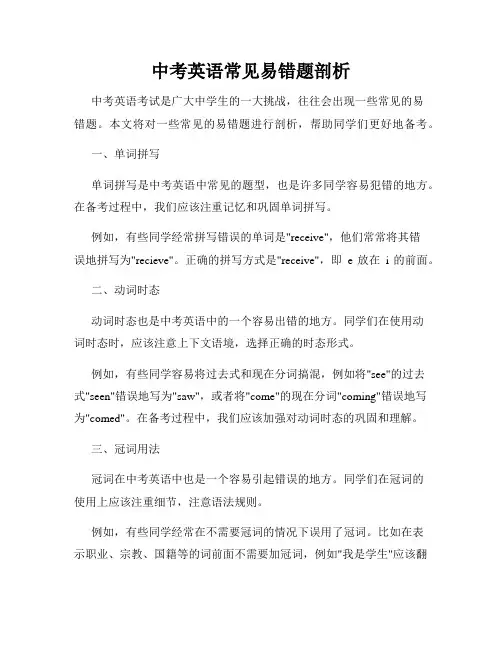
中考英语常见易错题剖析中考英语考试是广大中学生的一大挑战,往往会出现一些常见的易错题。
本文将对一些常见的易错题进行剖析,帮助同学们更好地备考。
一、单词拼写单词拼写是中考英语中常见的题型,也是许多同学容易犯错的地方。
在备考过程中,我们应该注重记忆和巩固单词拼写。
例如,有些同学经常拼写错误的单词是"receive",他们常常将其错误地拼写为"recieve"。
正确的拼写方式是"receive",即e放在i的前面。
二、动词时态动词时态也是中考英语中的一个容易出错的地方。
同学们在使用动词时态时,应该注意上下文语境,选择正确的时态形式。
例如,有些同学容易将过去式和现在分词搞混,例如将"see"的过去式"seen"错误地写为"saw",或者将"come"的现在分词"coming"错误地写为"comed"。
在备考过程中,我们应该加强对动词时态的巩固和理解。
三、冠词用法冠词在中考英语中也是一个容易引起错误的地方。
同学们在冠词的使用上应该注重细节,注意语法规则。
例如,有些同学经常在不需要冠词的情况下误用了冠词。
比如在表示职业、宗教、国籍等的词前面不需要加冠词,例如"我是学生"应该翻译为"I am a student",而不是"I am an student"。
在备考过程中,我们应该注意这些冠词用法的细节,避免犯错。
四、连词使用连词是中考英语中常见的易错题型之一。
同学们在备考过程中应该熟练掌握各种连词的用法。
例如,有些同学在使用并列连词时会犯错误。
比如将"and"后面的句子作为并列句子的主语,导致句子结构错误。
正确的用法是将"and"后面的句子作为并列句子的谓语或宾语,例如"I like music and I can dance"。
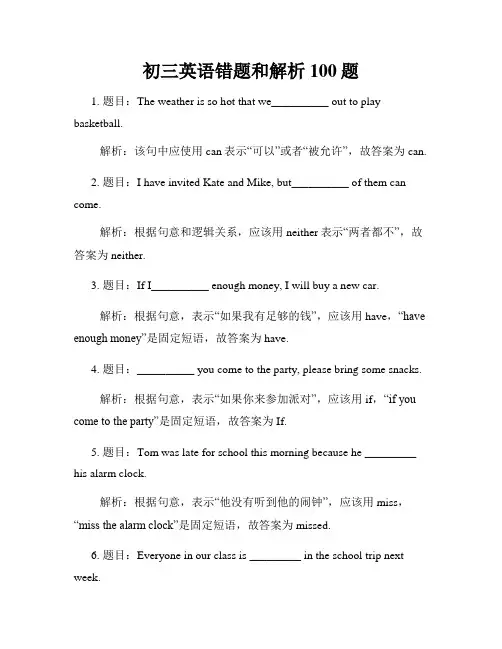
初三英语错题和解析100题1. 题目:The weather is so hot that we__________ out to play basketball.解析:该句中应使用can表示“可以”或者“被允许”,故答案为can.2. 题目:I have invited Kate and Mike, but__________ of them can come.解析:根据句意和逻辑关系,应该用neither表示“两者都不”,故答案为neither.3. 题目:If I__________ enough money, I will buy a new car.解析:根据句意,表示“如果我有足够的钱”,应该用have,“have enough money”是固定短语,故答案为have.4. 题目:__________ you come to the party, please bring some snacks.解析:根据句意,表示“如果你来参加派对”,应该用if,“if you come to the party”是固定短语,故答案为If.5. 题目:Tom was late for school this morning because he _________ his alarm clock.解析:根据句意,表示“他没有听到他的闹钟”,应该用miss,“miss the alarm clock”是固定短语,故答案为missed.6. 题目:Everyone in our class is _________ in the school trip next week.解析:根据句意,表示“对下周的学校旅行感到兴奋”,应该用excited,“excited about the school trip”是固定短语,故答案为excited.7. 题目:The film was _________ good that I watched it twice.解析:根据句意,表示“这部电影非常好”,应该用so,“so good”是固定短语,故答案为so.8. 题目:Jennifer has been _________ for ten years. She knows a lot about fashion.解析:根据句意,表示“Jennifer从事时尚工作已经十年了”,应该用in,“in fashion”是固定短语,故答案为in.9. 题目:I'm sorry I _________ my key at home. I can't get into the house.解析:根据句意,表示“我把我的钥匙忘在家里了”,应该用left,“left my key at home”是固定短语,故答案为left.10. 题目:The little girl _________ at the sight of the spider.解析:根据句意,表示“小女孩一看到蜘蛛就哭了”,应该用cried,“cried at the sight of the spider”是固定短语,故答案为cried.......(继续完成剩余的90道题目)通过以上100道题目的解析,我们可以学到很多英语知识和语法规则。
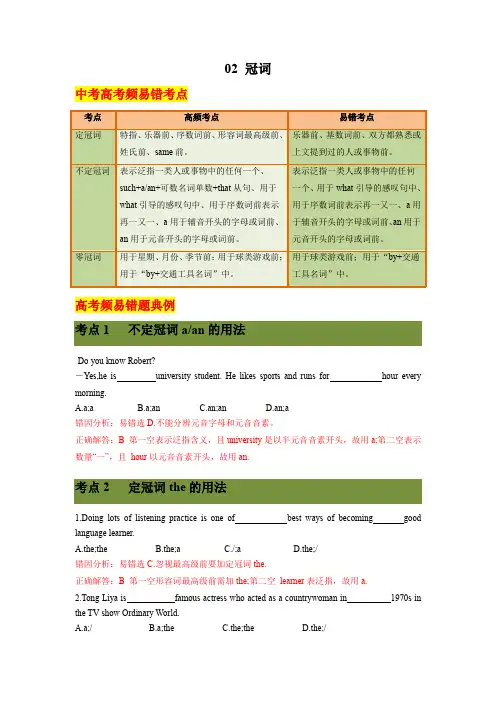
02 冠词中考高考频易错考点高考频易错题典例考点1 不定冠词a/an的用法-Do you know Robert?-Yes,he is university student. He likes sports and runs for hour every morning.A.a;aB.a;anC.an;anD.an;a错因分析:易错选D.不能分辨元音字母和元音音素。
正确解答:B 第一空表示泛指含义,且university是以半元音音素开头,故用a;第二空表示数量“一”,且hour以元音音素开头,故用an.考点2 定冠词the的用法1.Doing lots of listening practice is one of best ways of becoming good language learner.A.the;theB.the;aC./;aD.the;/错因分析:易错选C.忽视最高级前要加定冠词the.正确解答:B 第一空形容词最高级前需加the;第二空learner表泛指,故用a.2.Tong Liya is famous actress who acted as a countrywoman in 1970s in the TV show Ordinary World.A.a;/B.a;theC.the;theD.the;/错因分析:易错选A.分不清年代和年份前冠词的使用。
正确解答:B 第一空表泛指用不定冠词a;第二空表示“在20世纪70年代”,在表示时期、年代、世纪的名词前用the.考点3 零冠词的用法1.Do you know when is No Tobacco(烟草)Day?A.anB.aC.theD./错因分析:易错选C.误认为此处表示特指,忽略了节日前不加冠词。
正确解答:D “No Tobacco Day”为“无烟日”,在表示节日、季节、月份等的名词前不用冠词。
2.-Does your father go to work by car every day?-No,he sometimes takes bus.A.a;theB.the;aC./;aD.a;/错因分析:易错选A.分不清交通工具类名词前冠词的使用。

初中中考英语必考易错题含答案解析1、We can’t buy ( ) much mutton with ( ) little moneyA. so,muchB.such,soC.so,soD.such,such【解析】such...that,such修饰名词,但是当名词前有many,much,little,few等修饰时,用so代替such.答案为C。
2、---Excuse me,______ I don’t think you can smoke here ----Sorry I didn’t know this is none-smoking zoneA. andB.butC.soD.then【解析】对不起,---我认为你不能在这里抽烟。
B 表示转折。
答案为B.3、All except Tom have passed the exam because he _____ lots of classesA.leftB.forgotC.missedD.lost【解析】left 留下,forgot 留下,忘记 missed 错过 lost 丢失答案为C。
4、 Tom ______ there for months since he ______ back to his hometownA. has lived, getsB. has lived, gotC. lived, goD. lived, has got【解析】Tom自从回到他的家乡,他已经在那生活了10个月了。
since引导的时间状语从句,主句用现在完成时从句用一般过去式答案选B5、She doesn’t know the school, but it’s ( ) to be quite a good oneA. toldB.spokenC.talkedD.said【解析】It’s said to ...据说她不知道这个学校,但是据说是相当好的一个。
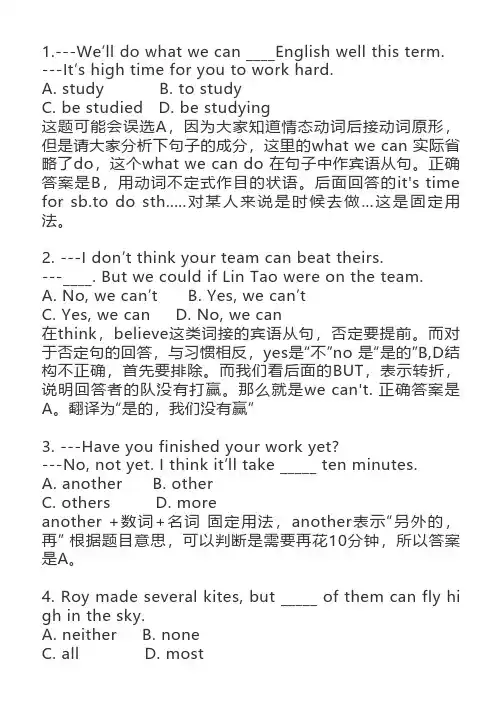
1.---We’ll do what we can ____English well this term. ---It’s high time for you to work hard.A. studyB. to studyC. be studiedD. be studying这题可能会误选A,因为大家知道情态动词后接动词原形,但是请大家分析下句子的成分,这里的what we can 实际省略了do,这个what we can do 在句子中作宾语从句。
正确答案是B,用动词不定式作目的状语。
后面回答的it's time for sb.to do sth.....对某人来说是时候去做...这是固定用法。
2. ---I don’t think your team can beat theirs.---____. But we could if Lin Tao were on the team.A. No, we can’tB. Yes, we can’tC. Yes, we canD. No, we can在think,believe这类词接的宾语从句,否定要提前。
而对于否定句的回答,与习惯相反,yes是“不”no 是“是的”B,D结构不正确,首先要排除。
而我们看后面的BUT,表示转折,说明回答者的队没有打赢。
那么就是we can't. 正确答案是A。
翻译为“是的,我们没有赢”3. ---Have you finished your work yet?---No, not yet. I think it’ll take _____ ten minutes.A. anotherB. otherC. othersD. moreanother +数词+名词 固定用法,another表示“另外的,再” 根据题目意思,可以判断是需要再花10分钟,所以答案是A。
4. Roy made several kites, but _____ of them can fly hi gh in the sky.A. neitherB. noneC. allD. mostneither "两者中任何一个都不" all "三者或三者以上都" most"大部分" 根据题目意思,只有none表示“一个都没有”没有确定的数量,不知道是2个还是3个或3个以上。
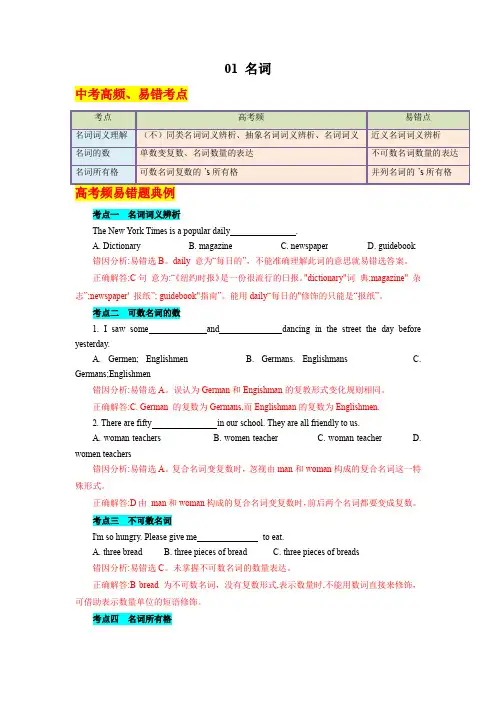
01 名词中考高频、易错考点考点一名词词义辨析The New York Times is a popular daily .A. DictionaryB. magazineC. newspaperD. guidebook错因分析:易错选B。
daily 意为“每日的”,不能准确理解此词的意思就易错选答案。
正确解答:C句意为:“《纽约时报》是一份很流行的日报。
"dictionary"词典;magazine" 杂志”;newspaper' 报纸”; guidebook"指南”。
能用daily“每日的"修饰的只能是“报纸”。
考点二可数名词的数1. I saw some and dancing in the street the day before yesterday.A. Germen; EnglishmenB. Germans. EnglishmansC. Germans;Englishmen错因分析:易错选A。
误认为German和Engishman的复教形式变化规则相同。
正确解答:C. German 的复数为Germans,而Englishman的复数为Englishmen.2. There are fifty in our school. They are all friendly to us.A. woman teachersB. women teacherC. woman teacherD. women teachers错因分析:易错选A。
复合名词变复数时,忽视由man和woman构成的复合名词这一特殊形式。
正确解答:D由man和woman构成的复合名词变复数时,前后两个名词都要变成复数。
考点三不可数名词I'm so hungry. Please give me to eat.A. three breadB. three pieces of breadC. three pieces of breads错因分析:易错选C。
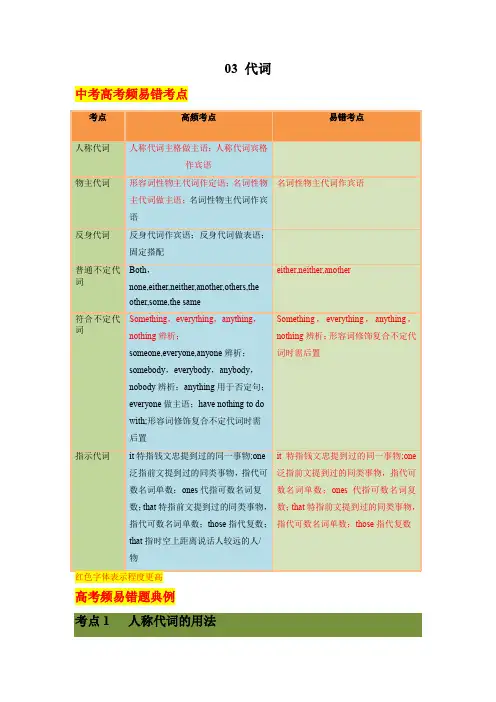
03 代词中考高考频易错考点高考频易错题典例考点1 人称代词的用法We decide to make a rule for us room-mates to turn off the lights at 10:30 p.m.A.thatB.thisC.itD.one错因分析:易错选A.忽视it作形式宾语的用法。
正确解答:C 句意为:“我们寝室决定把晚上十点半熄灯定为一个规定。
”空格处为形式宾语,真正的宾语为其后的不定式短语,故选it.考点2 物主代词的用法I don't like watch.I like .A.me;yourB.my;yourC.me;yoursD.my;yours错因分析:易错选B.未掌握形容词性物主代词与名词性物主代词的区别。
正确解答:D 句意为:“我不喜欢我的手表。
我喜欢你的(手表)。
”两个空均表示所有关系,所以用物主代词。
第一空修饰名词watch,用形容词性物主代词;第二空用名词性物主代词yours,作动词like的宾语,相当于your watch.考点3 反身代词的用法-Judy and I will go to the beach tomorrow.-It's so nice.Enjoy .A.yourselvesB.yourselfC.herself错因分析:易错选B.忽视Judy and I表示复数概念。
正确解答:A enjoy oneself为固定短语,意为“玩得开心”,又由Judy and I可知,是两个人,因此反身代词应用复数形式。
考点4 不定代词的用法1.My host family tried to cook for me when I studied in New Zealand.A.different somethingB.different anythingC.something differentD.anything different错因分析:易错选A.未掌握形容词修饰不定代词的用法。
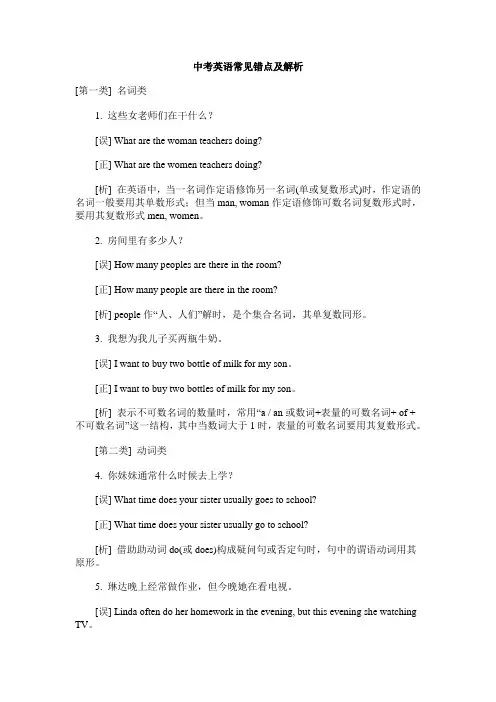
中考英语常见错点及解析[第一类] 名词类1. 这些女老师们在干什么?[误] What are the woman teachers doing?[正] What are the women teachers doing?[析] 在英语中,当一名词作定语修饰另一名词(单或复数形式)时,作定语的名词一般要用其单数形式;但当man, woman作定语修饰可数名词复数形式时,要用其复数形式men, women。
2. 房间里有多少人?[误] How many peoples are there in the room?[正] How many people are there in the room?[析] people作“人、人们”解时,是个集合名词,其单复数同形。
3. 我想为我儿子买两瓶牛奶。
[误] I want to buy two bottle of milk for my son。
[正] I want to buy two bottles of milk for my son。
[析] 表示不可数名词的数量时,常用“a / an或数词+表量的可数名词+ of +不可数名词”这一结构,其中当数词大于1时,表量的可数名词要用其复数形式。
[第二类] 动词类4. 你妹妹通常什么时候去上学?[误] What time does your sister usually goes to school?[正] What time does your sister usually go to school?[析] 借助助动词do(或does)构成疑问句或否定句时,句中的谓语动词用其原形。
5. 琳达晚上经常做作业,但今晚她在看电视。
[误] Linda often do her homework in the evening, but this evening she watching TV。
[正] Linda often does her homework in the evening, but this evening she is watching TV。
初三英语易错题及解析一、引言初三阶段是英语学习的一个重要阶段,在这个阶段,学生们面临着英语知识的综合应用和提升。
在这个过程中,学生们往往会遇到一些易错题,这些题目不仅考验着学生的英语基础知识,更考验着学生的解题技巧和思维能力。
因此,本文将针对初三英语易错题进行解析,帮助学生们更好地理解和掌握英语知识,提高解题能力。
二、易错题解析1. 词汇题易错点:学生们在词汇题中常常混淆近义词或一词多义的情况,导致答案不准确。
示例题:题干:What does the word “protect” mean in the sentence “The sculpture is protected with a fence”?A) 守护 B) 伤害 C) 覆盖 D) 保护解析:这道题考查的是词汇“protect”的意思。
在句子中,“保护”是指用栅栏等物体来防止雕塑受到破坏或侵蚀。
因此,正确答案是D) 保护。
在遇到一词多义的词汇题时,学生们应该结合上下文和词义辨析来选择正确的答案。
2. 语法题易错点:学生们对语法规则的理解不够深入,导致语法使用错误。
示例题:原文:John was surprised to see a stranger enter his room without permission.问:句中的主语、谓语、宾语、状语和定语分别是什么?错误答案:主语John,谓语see,宾语a stranger,状语to enter his room without permission。
解析:这道题考查的是句子的基本成分和语法结构。
正确的答案是:主语John,谓语surprised,不定式短语to enter his room without permission作状语,而a stranger enter his room是独立主格结构作补充说明。
在语法题中,学生们需要了解各种语法规则,并根据句子的实际语境进行判断。
易错点07 非谓语动词易错考点【01】后加动词不定式与动名词的固定用法辨析及其否定结构好多学生因为对一些固定用法掌握不牢,而用错动名词或不定式。
中考常考后接动词不定式的常考词有:begin,choose,continue,decide,expect,fail,forget,hate,help,hope,learn,manage,mean,need,offer,plan,prefer,pretend,promise,refuse,try,afford,agree,start,like等。
后加动名词的可以借助口诀来帮助记忆:完成练习值得忙(finish,practice,be worth,be busy)继续习惯别放弃(keep on,be used to,give up)考虑建议不禁想(consider, suggest, can't help, feel like);喜欢思念要介意(enjoy, miss, mind)动词不定式的否定结构:not to do sth.动名词的否定结构:not doing sth.易错考点【02】动词不定式和动名词的作主语用法辨析动名词主语多表习惯或一般,Reading in the sun is bad for our eyes.不定式作主语时,一是表目的,二是多用it 做形式主语。
It’s adj to do sth.To get there faster, you can take the taxi.易错考点【03】现在分词与过去分词的辨析1.语态区分:现分表主动或正在进行,如a moving film, developing countries过分表被动或已完成,如the moved people, the risen sun2.作宾补:宾补现分作宾补,主动关系,I heard him singing in the classroom.过分作补,被动关系。
名师课件中考英语必考易错题含答案解析1、It’s very warm-hearted ______ you to get the tickets ______ the World CupA. for, ofB. of, forC. of, toD. to, for【解析】warm-hearted指人的特征,用of. the ticket to sth.类似的有:the answer to thequestion ,故答案为C。
2、---The artist has got _____ much work to do that he hardly has time to help his wifewith the housework ---That’s trueEven on Sundays he is busy with his workA.tooB.soC.veryD.such【解析】such 修饰名词,但是如果名词前有much,many,little,few修饰时,用so代替such.答案为B. 这题不能看成too..to结构。
3、 ---I’m sorry to have kept you waiting long ---Never mind I ____ here for only a few minutesA. have beenB. have comeC. have arrivedD. waited【解析】因为come,arrive是瞬间动词,在用于现在完成时时,不能与表示一段的for,since构成的时间状语连用。
答案为A。
4、---Dad,what’s the sea like? ---Well,it’s large and full of water It covers about _____ of the earthA.one thirdB.three quarterC.three-fourthD.three quarters【解析】我们知道海占了地球的大部分。
初中中考英语必考易错题含答案解析1、 ---Do you know the result of the race? ---Yes The winner is a boy Lin Feng from ClassA. 100-metres, calledB. 100-metre, callingC. 100-metre, calledD. 100-metres, named 【解析】数词+名词+形容词作定语,中间用连词符号,且中间的名词用单数。
这里我们可以看作100-metre-long 省略了long。
小孩被叫Lin Feng用被动的形式。
答案为C。
2、 They ______ very busy last monthA. areB. wereC. beD. have been【解析】从last month可以看出,句子用过去时。
答案为B3、 I went home and _____ my schoolbag and started to help Mother do the cookingA. put offB. dropped offC.turned offD.shut off【解析】put off 脱掉(衣服),推迟 turn off 关掉 shut off 比较常用于关闭液体(水、油)或气体(瓦斯、天然气)的阀门drop off 放下答案为B。
4、---Could you tell me how to improve spoken English ? ---Well,just take every chance to practise ______and don’t be shyA. speakB.to speakC. speakingD.spoke【解析】你能告诉我怎样提高英语口语吗?---抓住每个机会练习说,不要害羞。
答案为C。
practise 练习,后面接名词或动名词,不接不定式。
中考英语易错题及解析中考英语易错题及解析:1. 某一题目是句子转换题,要求学生将给定的句子改为被动语态。
下面哪一组改变是正确的?原句子:His father took him to the zoo yesterday.A. He was taken to the zoo by his father yesterday.B. He took his father to the zoo yesterday.C. Yesterday he was taken to the zoo by his father.D. He took his father yesterday to the zoo.解析:答案为A。
句子的主语与宾语在被动语态中会有所调整,他们之间的关系也会发生改变。
因此,正确的改变应该是将“His father took him”变为“he was taken”。
另外,在被动语态中,介词一般不会发生变化。
2. 某一题目要求学生正确使用代词。
下面哪一组代词使用是错误的?A. She gave me the book, and then she took it away.B. They asked me to call them, and I did it yesterday.C. He told her that he loved her, and then she did.D. I saw him yesterday, and he said he would call us.解析:答案为C。
在C选项中,第二个代词“she”指代的是“her”,但是这种代词的使用是错误的,因为没有清楚的指代关系。
正确的做法是将第二个代词改为“him”。
3. 某一题目要求学生正确使用动词的时态。
下面哪一个选项是不正确的?A. We have already finished our homework before the teacher came.B. I will go to the park with my sister tomorrow if it doesn't rain.C. He is writing a letter to his friend now.D. She was reading a book when the phone rang.解析:答案为A。
中考易错题分析1. It is _______ outside. Let’s put on our raincoats and go out, Tom.A. coldB. hotC. sunnyD. rainy【解析】此题易误为A。
因为这里有个put on短语,如果不注意raincoats这个词那就很可能草率地选择A。
raincoats是“雨衣”的意思,而不是一般的衣服,那么不是因为外面“冷”,而是因为“下雨”才穿“雨衣”。
正确答案为D。
典型形容词和副词考题分析1. We should keep _______ in the reading-room.A. quiteB. quietlyC. quietD.quickly【解析】此题容易误选A或B。
选A是由于不细心,把quite当成是quiet,草率做题造成的;选B是由于把keep误认为是一般的实义动词,修饰实义动词当然得用副词。
其实,这里的keep连系动词,后面要接形容词作表语。
正确答案为C。
2. The light in the room wasn’t _______for me to read.A. enough brightB. brightly enoughC. enough brightlyD. bright enough【解析】此题容易误选A或B。
选A的人是受的汉语思维的影响,enough bright翻译过来正好是“足够明亮”的意思,其实这并不符合英语的习惯,在英语中当enough修饰形容词或副词时一定要后置;选B的人没有注意所缺的成分是表语,作表语时应该用形容词而不用副词。
正确答案为D。
三道易错名词考题分析2. There are a lot _______ people today than yesterday.A. ofB. /C. mostD. more【解析】此题容易误选A。
有不少考生因受“ a lot of +名词”这一思维定势的影响,一看到a lot,就选择了A。
中考英语常见易错题分类解析Aa[误] I think it is an useful English dictionary.[正] I think it is a useful English dictionary.[析]在不定冠词a与an的用法中要注意的一点是:an用在以元音开头的词之前;而a则用在以辅音开头的词之前。
要特别注意的是以u字母打头的单词,如useful,university等,其第一个音标是[j],所以要特别予以注意。
[误] I need a hour to finish this letter.[正] I need an hour to finish this letter.[析]要注意hour和honest的第一个字母不发音。
[误] My teacher is a unknown man, but he is a very good man.[正] My teacher is an unknown man, but he is a very good man.[析]要注意以u打头的单词,它的发音为[an,如uncle等。
[误] There is a "f" in the word "football".[正] There is an "f" in the word "football".[析]英文字母单独使用时,如其第一个发音是元音时,其前面的不定冠词应该用an而不是a.[误] I have a little brother. He is a 8year old boy.[正] I have a little brother. He is an 8year old boy.[析]要注意这些字母的第一个发音为元音,如eight, eleven等。
able[误] This bike is able to be repaired.[正] This bike can be repaired.[析] be able to 主要表达某事或某人具有某种能力去作某事,应译为"有本领"、"有能力"、"可以"作某事,如:I'm able to swim across this river. 而can可以用来表示具有接受能力或吸收能力。
如:This radio can be repaired here.about[误] This class is about to begin just now.[正] This class is about to begin.[析]要注意be about to 是"将要"的意思,含有将来时之意,不要与表示过去时的时间状语连用。
另外,be about to 一般用作书面语,对应的口语是be going to.about onabout与on都可以作"关于"讲,但却有所不同,例如:This book is about physics. 应译为"这是一本关于物理学的科普读物。
"而:This book is onphysics.则应译为"这是一本物理学方面的专著。
"above[误] The temperature is five degrees over zero.[正] The temperature is five degrees above zero.[析]表达"在……上方"时,above与over是可以互换的,如:The sky is above(or over)our heads. 但是要表达在垂直方向上的上方时则应用above不可用over,如:The sun has risen above the horizon.[误] There is often thick cloud above the South of China in summer.[正] There is often thick cloud over the South of China in summer.[析]当表达覆盖之意时,只可用over而不能用above.[误] There is a bridge above the river.[正] There is a bridge over the river.[析]用来表达"从……上方越过"时不能用above只能用over,如:The plane flew over the city. 但要注意There is waterfall above the bridge. 则应译为"在桥的上游有一个瀑布。
"across[误] He ran across the wood.[正] He ran through the wood.[析] across是指某一动作在一平面内进行,而through则是指该动作在一三维立体空间的运动过程。
如:The man came in through the window. He walked across the square.acrossacross的主要用法有两个。
其一,意为"对面",如:There is a school just across the street. 其二,意为"横过",如:He walked across the street.afraid[误] I dont't afraid of him.[正] I am not afraid of him.[析]要注意"害怕"afraid一词在英语中不是动词,而是形容词,要与be动词连用。
after[误] Two weeks after he left.[正] Two weeks later he left.[正] He left after two weeks.[析]要表达"在多少时间之后",英语中有两种表达法,即:用later时,要时间在前,如three hours later; 而用after时要时间在后,如after three hours.[误] My father will be back after a few hours.[正] My father will be back in a few hours.[析]受中文的影响,这个介词常常被误用。
当你要表达在一段时间内某个动作可以完成时,一定要用in,而不能用after,因为after是指在某一时间之后。
例如:This work will be done in two days. 即表明在两天内这一工作一定会做完。
而如用了after,即表示在两天之后,完成的时间是不确定的。
after behindafter多用于表示顺序的前后,如:She walked in the line after Tom. 或用来表示"追赶",表示一种动态,如:He ran after Mary. 而behind多用于强调先进与落后,如:She is much behind the other girls in sewing. 或者用于表达"迟于",如:The train was ten minutes behind the time table. 或者与表示静态的动词连用,如:She hid herself behind the flowers. afternoon[误] He worked very hard in a hot afternoon.[正] He worked very hard on a hot afternoon.[析]习惯用的词组in the afternoon, 如果加入任何修饰词后其前面的介词in都要改为on,不论其修饰词在前还是在后,如:He swam in this river on the afternoon of June lst. 又如:Are you free on Sunday afternoon?against[误] He against me.[正] He is against me.[析]要注意against意为"反对",但它在英文中却不是动词,而是介词,如要讲反对某事或某人时则要加动词be, 如:He is againstsomebody/something.against foragainst意为"反对"、"不赞成";而for则意为"同意",为其反意词。
如:Are you for or against the plan?age[误] He is twenty years old of age.[正] He is twenty.[正] He is twenty years old.[正] He is at the age of twenty.ago[误] Tom's father has been dead five years ago.[正] Tom's father died five years ago.[析] ago意为由说话时算起,若干时间以前。
它只能和一般动词过去时连用,而不要与完成时连用。
[误] Yesterday I met a friend. We didn't see each other for a long time since we left the college twenty years ago.[正] Yesterday I met a friend. We hadn't seen each other for a long time since we left the college twenty years ago.[析]要注意的是在本句是ago是用在由since引起的从句之中,只是从句应用过去时,但不影响主句的时态。
agree[误] Does the teacher agree to us?[正] Does the teacher agree with us?[误] Does he agree with our plan?[正] Does he agree with us?[析] agree with 指"同意某人的提议、建议、计划"等。